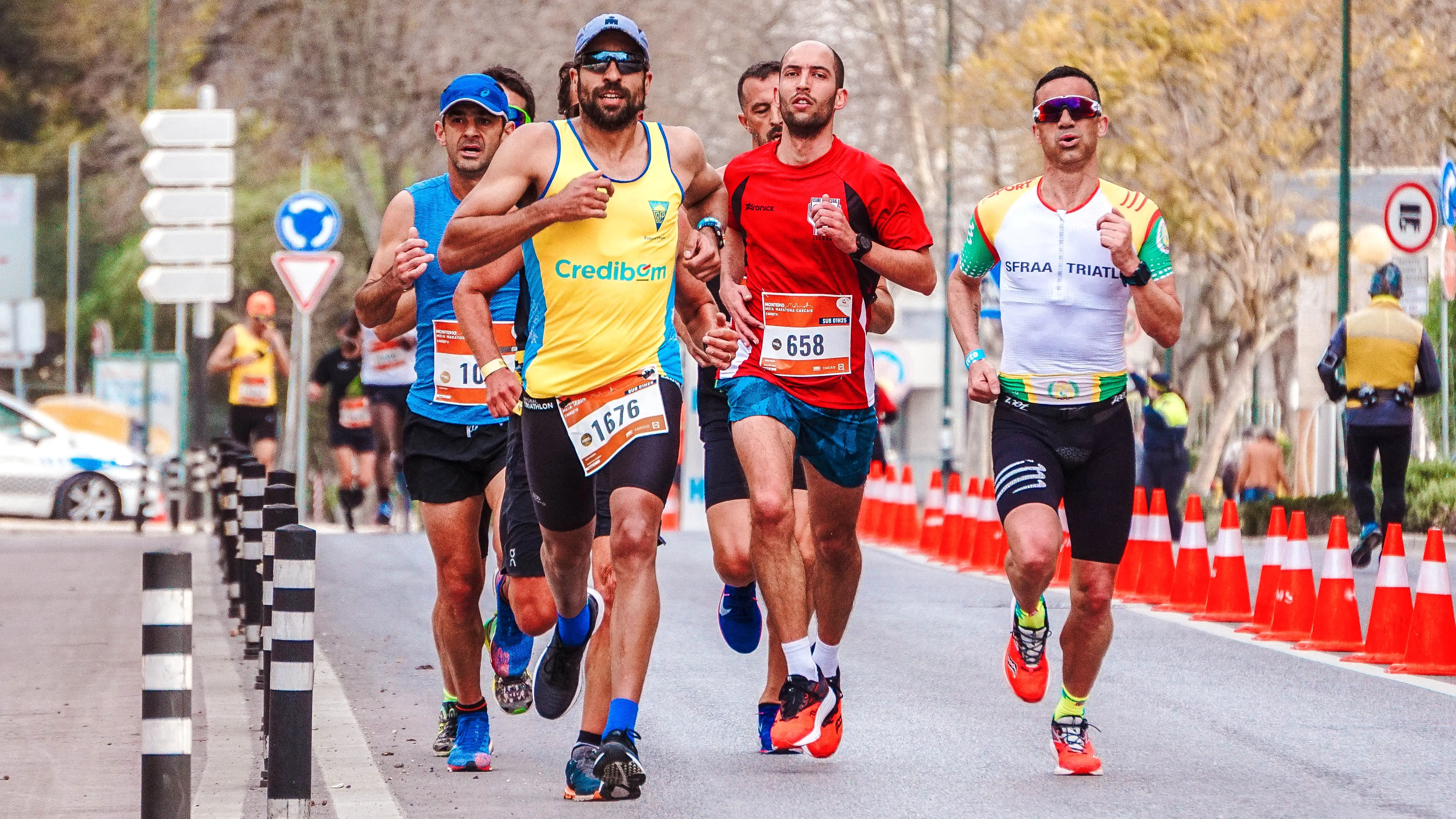Running Your First 21k: Tips and Tricks for a Successful Half Marathon
Getting Started with Your 21k Training
Congratulations on taking the first step towards running your first 21k! It's a challenging but achievable goal with the right training plan and mindset. In this section, I'll guide you through the key steps to get started with your training.

Setting Realistic Goals
Before starting your training, it's important to set realistic goals. Your goal should be specific, measurable, achievable, relevant, and time-bound. For example, your goal could be to finish the 21k race in 2 hours and 30 minutes. This gives you a specific target to work towards and a deadline to achieve it.
It's also important to set intermediate goals to keep you motivated and on track. For example, you could set a goal to run 10k without stopping within the first 6 weeks of your training plan. This will give you a sense of accomplishment and progress towards your ultimate goal.
Choosing the Right Gear
Having the right gear is essential for long-distance running. You'll need a good pair of running shoes that provide support and cushioning to prevent injuries. Look for shoes that are specifically designed for long-distance running and fit well.
You'll also need comfortable and breathable clothing that is suitable for the weather conditions. Consider investing in moisture-wicking fabric that will keep you dry and comfortable during your runs.
Understanding the Basics of Long-Distance Running
Long-distance running requires a different approach than shorter distances. You'll need to focus on building endurance and stamina over time. It's important to start slow and gradually increase your mileage each week. A good rule of thumb is to increase your mileage by no more than 10% each week.
In addition to running, you'll also need to incorporate strength training and cross-training into your routine. This will help prevent injuries and improve your overall fitness. Consider working with a coach or trainer to develop a personalized training plan that meets your specific needs and goals.
By setting realistic goals, choosing the right gear, and understanding the basics of long-distance running, you'll be well on your way to completing your first 21k race. Remember to stay motivated, stay focused, and enjoy the journey!
Developing Your Training Plan
When it comes to running a half marathon for the first time, developing a training plan is essential to ensure that you are physically and mentally prepared for the challenge. Here are some key considerations for crafting a training plan that works for you.
Crafting a Weekly Schedule
One of the most important aspects of your training plan is creating a weekly schedule that you can stick to. This should include a mix of running, cross-training, and rest days. A typical training plan for a half marathon will involve running three to four times per week, with one or two days of cross-training and at least one rest day.
To create your own weekly schedule, start by determining how many days per week you can realistically commit to training. Then, decide which days will be your rest days and which will be your cross-training days. Finally, schedule your runs for the remaining days, making sure to spread them out evenly throughout the week.
Incorporating Interval Training
In addition to your regular runs, it's also important to incorporate interval training into your training plan. Interval training involves alternating periods of high-intensity running with periods of rest or low-intensity running. This type of training can help improve your speed and endurance, making it a valuable addition to any half marathon training plan.
To incorporate interval training into your plan, start by adding one or two interval workouts per week. These can be done on a track or on the road, and should involve running at a high intensity for short periods of time, followed by periods of rest or low-intensity running.
Balancing Long Runs and Recovery
Finally, it's important to balance your long runs with adequate recovery time. Long runs are an essential part of any half marathon training plan, as they help build endurance and prepare your body for the distance. However, it's important to give your body time to recover after each long run to prevent injury and avoid burnout.
To balance your long runs and recovery time, schedule your long runs for the same day each week (typically on the weekend) and make sure to give yourself at least one recovery day afterwards. Additionally, make sure to incorporate rest days and cross-training into your schedule to help your body recover and prevent injury.
Nutrition and Hydration Strategies
Eating for Endurance
As I prepare for my first 21k, I understand that nutrition plays a vital role in my performance. Eating a balanced diet that includes carbohydrates, protein, fats, vitamins, and minerals is essential to ensure that my body has the necessary fuel to keep going for the duration of the race.
To fuel my body for endurance, I plan to eat a meal rich in carbohydrates, such as pasta or rice, a few hours before the race. I will also eat a small snack, such as a banana or an energy bar, about an hour before the race to provide my body with the necessary energy to start the race.
During the race, I plan to eat small amounts of easily digestible carbohydrates, such as energy gels or sports drinks, to keep my energy levels up. I will also carry a small snack, such as a granola bar or a banana, in case I need an extra boost of energy.
Staying Hydrated During Training and Races
Staying hydrated is crucial for runners, especially during long-distance runs like a 21k. Dehydration can lead to fatigue, muscle cramps, and other health issues, which can affect my performance.
To stay hydrated during training and races, I plan to drink plenty of water throughout the day. I will also carry a water bottle with me during my training runs and take sips of water every 10-15 minutes.
During the race, I will make sure to drink water or sports drinks at every hydration station to replenish the fluids lost through sweat. I will also pay attention to the color of my urine to ensure that I am adequately hydrated. If my urine is dark yellow, it is a sign that I need to drink more water.
In conclusion, proper nutrition and hydration strategies are essential for a successful 21k. By eating a balanced diet and staying hydrated, I can ensure that my body has the necessary fuel and fluids to perform at its best.
Injury Prevention and Health Tips
As I prepare for my first 21k, I know that injury prevention and maintaining good health are key to a successful race. In this section, I will discuss some strategies that I have found helpful for staying healthy and avoiding injuries during training.
Recognizing Common Running Injuries
It's important to be aware of common running injuries so that I can recognize them early and take steps to prevent them from becoming more serious. Some common injuries include:
-
Runner's knee: Pain around the kneecap that can be caused by overuse, improper footwear, or weak thigh muscles.
-
Plantar fasciitis: Pain in the heel or bottom of the foot caused by inflammation of the plantar fascia, a band of tissue that runs along the bottom of the foot.
-
Shin splints: Pain in the lower leg caused by overuse or stress on the shinbone and surrounding muscles.
If I experience any of these symptoms, I will take a break from running and focus on stretching, icing, and strengthening exercises to help prevent further injury.
Implementing Effective Warm-Up and Cool-Down Routines
Warming up before a run and cooling down afterward can help prevent injuries and improve performance. Here are some effective warm-up and cool-down exercises that I will incorporate into my training:
-
Warm-up: I will start with some light cardio, such as jogging or jumping jacks, to get my heart rate up. Then, I will do some dynamic stretches, such as leg swings and walking lunges, to help loosen up my muscles and prepare them for the run.
-
Cool-down: After the run, I will do some static stretches, such as hamstring stretches and calf stretches, to help prevent muscle soreness and improve flexibility. I will also do some light cardio, such as walking or jogging, to help bring my heart rate back down gradually.
By implementing these injury prevention and health tips into my training routine, I am confident that I will be able to stay healthy and injury-free as I prepare for my first 21k.
Frequently Asked Questions
How long does it take to train for a half-marathon?
It depends on your current fitness level, running experience, and goal time. Generally, you should allow at least 12 weeks of consistent training to build up your endurance and speed. You can follow a training plan that suits your needs and abilities, such as the ones from Runner’s World or Verywell Fit.
How often should I run?
You should aim to run at least three times a week, with one long run, one speed or tempo run, and one easy or recovery run. You can also add some cross-training, such as cycling, swimming, or strength training, to improve your overall fitness and prevent injuries. Make sure you have at least one rest day per week to allow your body to recover and adapt.
How fast should I run?
Your running pace depends on your goal time, your current fitness level, and the terrain and weather conditions. A good way to determine your optimal pace is to use a [pace calculator] that takes into account your recent race times and your target distance. You can also use a [heart rate monitor] or a [perceived exertion scale] to gauge your effort level and adjust your pace accordingly.
How should I fuel and hydrate for a half-marathon?
You should eat a balanced diet that provides enough carbohydrates, protein, and healthy fats to support your training and recovery. You should also drink plenty of water and electrolytes to stay hydrated and avoid dehydration and cramps. Before the race, you should eat a light meal that contains mostly carbohydrates and some protein, such as a banana with peanut butter, oatmeal with milk, or toast with jam. During the race, you should consume some carbohydrates every 45 minutes to an hour, such as sports drinks, gels, chews, or dried fruits. After the race, you should eat a meal that contains both carbohydrates and protein, such as a sandwich, a smoothie, or a pasta dish, to replenish your glycogen stores and repair your muscles.
How should I deal with common running injuries and pains?
Running can cause some minor injuries and pains, such as blisters, chafing, shin splints, runner’s knee, or plantar fasciitis. To prevent and treat these issues, you should wear proper running shoes and socks, apply lubricant or tape to sensitive areas, warm up and cool down properly, stretch and foam roll regularly, and rest and ice the affected areas. If you experience severe or persistent pain, swelling, or inflammation, you should consult a doctor or a physiotherapist.
